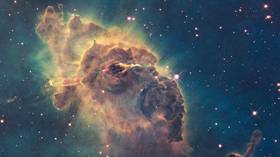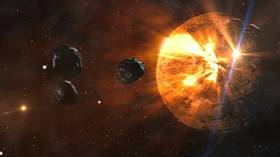Organic molecule that forms ‘building block for life’ found in interstellar space for 1st time

Organic molecules which form the building blocks for life have been detected in a vast cloud in the interstellar space near the center of the Milky Way galaxy for the first time, throwing open possibilities of how life forms.
The cloud is known as the Central Molecular Zone and has captivated astrochemists for decades but now the latest readings indicate the zone may have a bigger role to play in the emergence of life than we may have previously thought.
In this particular instance, researchers following a hunch detected the presence of propargylimine, believed to be a precursor for amino acids, a critical ingredient in the emergence and evolution of organic life.
“The peculiarity of this chemical species lays in its carbon-nitrogen double bond, which gives it a high reactivity… that lead[s] from the simplest and most abundant molecules in space… to the more complex amino acids, the fundamental building blocks of terrestrial biology,” explained astrochemist Luca Bizzocchi of the Max Planck Institute for Extraterrestrial Physics in Germany.
Also on rt.com There could be up to 6 billion Earth-like planets in the Milky Way according to explosive new researchFirstly, the researchers studied the spectrum of propargylimine in a lab, as different chemical compounds re-emit electromagnetic radiation at specific wavelengths providing a kind of chemical fingerprint made up of absorption and emission lines. These “molecular fingerprints” are critical to our understanding of the chemical makeup of distant star systems and help us to unlock key processes which underlie both the formation of the universe and life itself.
“As a molecule rotates in the interstellar medium it emits photons at very precise frequencies,” Bizzocchi explained. “This information, when combined with data from radio telescopes, allows us to know whether a molecule is present in the molecular clouds, the sites of star and planet formation.”
The team then compared their laboratory findings with readings taken by the 30-meter telescope in Sierra Nevada, Spain, focusing on a specific cloud in the Central Molecular Zone.
“Our molecule was already there,” said astrophysicist Victor M. Rivilla of the National Institute for Astrophysics in Italy.
This kind of research helps to fill gaps in our knowledge about distant structures like the vast gas clouds which inhabit interstellar space, and could one day narrow down our search area as we hunt for evidence of life out there among the stars.
Also on rt.com Alien life could thrive on hydrogen worlds says new study, forcing rethink of how we hunt for ETThink your friends would be interested? Share this story!














